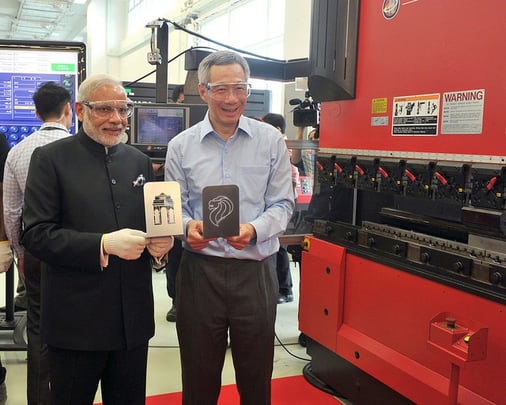A host of factors come into play when deciding where to manufacture your product and certainly a nation’s tax policy is high on the list. India helped itself, big time, this year when the Parliament passed and ratified the Goods and Services Tax (GST), a sweeping tax reform designed to enhance the nation’s ability to attract investment.
At a forum in Atlanta in mid-October, India’s Consul General Nagesh Singh praised the GST calling it the most significant financial reform since 1991. “The goods and services tax gets rid of the multiplicity of tax systems,” Singh said. Taxes will be levied at the central government level and at the state level which addresses the cascading effect of delays, human interaction and any other disruptors. “The estimated GDP growth could go up two more percentage points on the basis of this reform,” Singh added.

Indian Prime Minister Narendra Modi and Singapore's Prime Minister Lee Hsien Loong during a visit to the Institute of Technical Education in Singapore. (Photo courtesy of PMNarendaModi Flickr)
This excellent Q&A from Bloomberg breaks down the GST in digestible bits. Here are a few highlights:
- The GST aims to tax goods at the point of sale rather than the point of production.
- The government has committed that the GST will be implemented by April 2017.
- The tax rate is still to be determined but Prime Minister Modi’s chief economic advisor would like to see an 18 percent tax rate.
- While all sectors will benefit, one of the chief beneficiaries will be the logistics sector.
Ernst & Young calls GST “a game-changing reform for the Indian economy” creating a common Indian market and impacting “tax structure, tax incidence, tax computation, tax payment, compliance, credit utilization and reporting, leading to a complete overhaul of the current indirect tax system.”
The GST promises to impact everything from pricing and services to supply chain optimization and tax compliance systems. For more detailed information and analysis of GST in India, check out the EY website.
In addition to India's tax policy, other signs point to an economic power surge. In 2015, India attracted $44 billion in foreign direct investment (FDI), said the United Nations Conference on Trade and Development’s (UNCTAD) 2016 World Investment Report. What’s more, the report estimates foreign investment in India will rise to $60 billion in 2016, even as FDI declines slightly, globally. The loosening of capital, a large and educated workforce, and the nation's friendly financial policy are viewed as factors in the overall rise.
Top 5 in FDI (2015)
- Singapore
- Mauritius
- United States
- Netherlands
- Japan
Source: UNCTAD World Investment Report 2016
India's manufacturing sector will continue to grow by leaps and bounds. GE, Siemens, Foxconn and Boeing have all set up or announced plans to install manufacturing facilities there. By 2025, the India Brand Equity Foundation estimates manufacturing could account for up to 30 percent of the nation's GDP. Whatever you're producing, there's every reason in the world to consider having it "Made in India."
Intrigued by what India has to offer? Click below to download our free guide to determine whether India is the right fit for your business and supply chain.




.jpg?width=176&height=56&name=MR_associatedNetwork_logo%20(1).jpg)